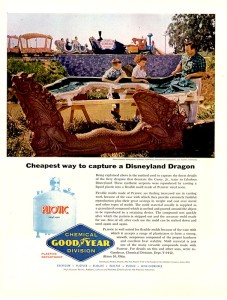Back when Disneyland was new, the company would regularly allow sponsors and partner-companies to use images from the park to advertise their products. A few of these ads—such as for the Hudson Hornet—would appear in big city newspapers, but most would appear in small-circulation trade journals. This image—which was published in October 1956—first appeared in the Chemical & Engineering News.
Here’s why I like it: in 1954, Walt Disney had purchased a carousel from Sunnyside Beach Park in Toronto, which he would later move to Anaheim, California. The carousel was filled with horses, circus animals (such as lions and giraffes) and ornate stationary benches, but Walt only wanted horses on his elegant carousel at Disneyland. The circus animals he mostly gave away (or sold for next to nothing) to studio employees. But the benches he saved so that they could be fashioned into cages and open cars on the Casey Jr. The Casey Jr. engine, however, was not built at the studio. It was built at a ride manufacturing company in Mountain View, California called Arrow Development. One of the machinists there, Karl Bacon was a genius with tin snips and metal tools and was able to hand-fashion the engine and the tender so that they appeared almost exactly like those in the film, Dumbo. Arrow Development also built the first car, a flatbed that housed the motor. (Click here for an amazing shot of the engine being tested at the Arrow plant: http://davelandweb.com/caseyjr/images/50s/CaseyJr_Construction.jpg ) Aside from paint, this left only one final element to finish the exterior design of the Casey Jr. A sculptor needed to create a façade to enclose the flatbed car that held the motor. In this advertisement, you can see the actual mold used to cast the exterior ornamentation for that flatbed car.
This photo appears to be taken in the spring of 1956. The new stone bridgework is finished (and oddly tinted here) for Storybook Land (which opened in June, 1956), but the landscaping is not yet complete. Here, the hills still hold the patchy “natural-yet-mowed” greenery (i.e. weeds) that covered the back part of Fantasyland for all of 1955 and part of 1956; they do not yet hold the gorgeous landscape designs that would appear a few months later when Storybook Land opened to the public. In this you can see how, even during the park’s first year of operation, Walt was radically improving Disneyland. He added landscaping, new structures and props until, eventually, his park existed as a beautifully controlled three-dimensional fantasy, a seamless dream.
Thanks to the good folks at the Goodyear Chemical Division for preserving part of this history in an image. (Click on image for a larger view.)


What an interesting ad! “Profiles in History” tried to auction off one of these dragon sculpts about a year ago. I don’t know if it sold, but they were asking $20,000 to $25,000!